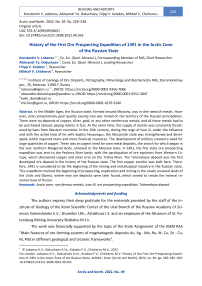History of the First Ore Prospecting Expedition of 1491 in the Arctic Zone of the Russian State
Автор: Lobanov K.V., Dokuchaev A.Ya., Kulakov F.V., Chicherov M.V.
Журнал: Arctic and North @arctic-and-north
Рубрика: Reviews and reports
Статья в выпуске: 49, 2022 года.
Бесплатный доступ
In the Middle Ages, the Russian state, formed around Moscow, was in dire need of metals. However, only comparatively poor quality swamp iron was mined on the territory of the Russian principalities. There were no deposits of copper, silver, gold, or any other nonferrous metals, and all these metals had to be purchased abroad, paying mainly in furs. At the same time, the supply of metals was constantly threatened by bans from Western countries. In the 15th century, during the reign of Ivan III, under the influence and with the active help of his wife Sophia Palaeologue, the Muscovite state was strengthened and developed, which required more and more financial resources. The development of artillery created a need for large quantities of copper. There was an urgent need for own metal deposits, the search for which began in the vast northern Novgorod lands, annexed to the Moscow state. In 1491, the first state ore prospecting expedition was sent to the Pechora River basin, with the participation of ore explorers from Western Europe, which discovered copper and silver ores on the Tsilma River. The Tsilemskoye deposit was the first developed ore deposit in the history of the Russian state. The first copper smelter was built here. Therefore, 1491 is considered to be the beginning of the mining and metallurgical industry in the Russian state. This expedition marked the beginning of prospecting, exploration and mining in the newly annexed lands of the Urals and Siberia, where new ore deposits were later found, which served to create the mineral resource base of Russia.
Arctic zone, non-ferrous metals, Ivan III, ore prospecting expedition, Tsilemskoye deposit
Короткий адрес: https://sciup.org/148329274
IDR: 148329274 | УДК: 553.3/.4(98)(09)(045) | DOI: 10.37482/issn2221-2698.2022.49.263
Текст научной статьи History of the First Ore Prospecting Expedition of 1491 in the Arctic Zone of the Russian State
Throughout its history, the Muscovite state experienced an extreme shortage of resources for the metallurgical industry. The development of the state and its strengthening led to a constant increase in the demand for non-ferrous and precious metals. Gold and silver were required for minting coins and jewelry, copper and tin — for casting bells, making cannons and various utensils.
However, the extraction and production of non-ferrous and precious metals were completely absent, and the need for them was covered exclusively by imports from abroad. The reason of it was the fact that till the middle of the 15th century, the Muscovite state had occupied a limited territory in the center of the Russian platform, the sedimentary cover of which did not contain non-ferrous metal deposits on the surface. Correspondingly, there was no possibility to learn and develop skills of searching and mining of such deposits, skills of metal extraction from ore, as it was done for many centuries on the territory of Western Europe in old mining areas (Fig. 1).
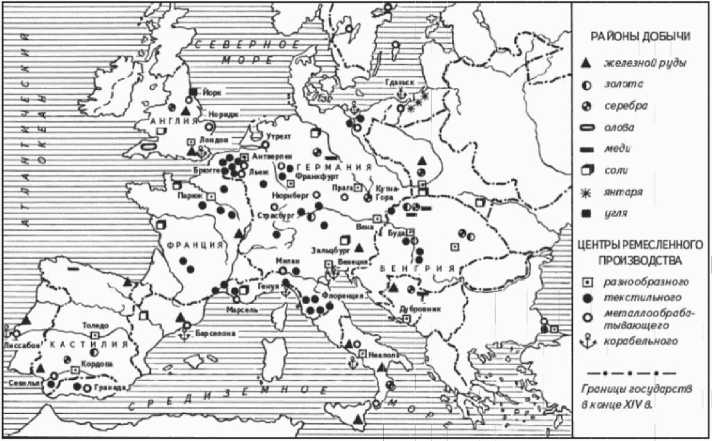
Fig. 1. Mining in Western Europe in the 14th century [8].
The situation escalated in the 15th century, when artillery began to develop actively. The production of bronze cannons required a lot of copper and tin. Almost all non-ferrous and precious metals, as well as a significant part of iron, had to be purchased abroad, paying mainly with furs. Furs, mined in Rus', were the main currency due to the lack of gold and silver. Imported metals were expensive. By that time, only iron production was developed in Rus'. It was produced from swamp ores and was of low quality. Therefore, iron had to be bought additionally in Germany and Sweden, although it was more expensive than Russian. Russian iron cost 60 kopecks/pood, and Swedish iron — 1 ruble, 30 kopecks/pood, imported iron wire — 1-3 rubles/pood, copper — 1.5-3 rubles/pood, roofing copper — up to 6 rubles/pood, tin — 5 rubles/pood, silver — 450 ru-bles/pood, gold — 3300 rubles/pood. For comparison: a horse cost 2 rubles, and a serf — 3–5 rubles.
The only metal that was mined and produced in significant quantities on the territory of Rus' was iron. Limonite (brown iron ore) was used for manufacture of iron. It occurred almost in all territory of Rus' in large quantities. Limonite was mined in swamps, which is why it was called “swamp ore” (Fig. 2).
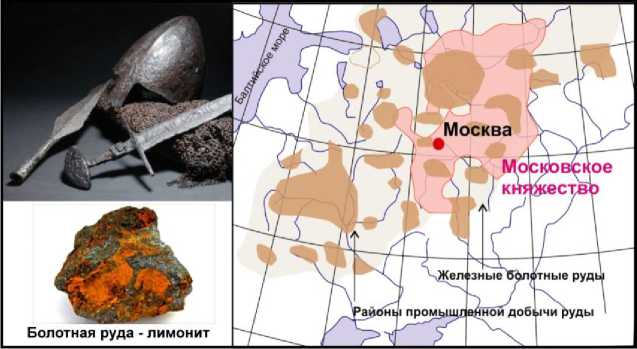
Fig. 2. Distribution of swamp ores in Russian lands and on the Moscow Principality territories in the 15th century.
In Rus', production technology of direct reduction of iron from ore was used. This method is called bloomery process. It was used in the world for almost 3000 years till the beginning of the 17th century. This way of obtaining iron was possible in simple, small furnaces — bloomeries. During the bloomery process, the rock was finely crushed and loaded into a furnace along with charcoal. Carbon monoxide, which arose during the combustion of coal at the bottom of the furnace, rose to the top, heated the ore and charcoal and reacted chemically with them. Part of the ore was reduced to metallic iron, and the rest was turned into slag. As the coal burned off, the solid pieces of iron were welded together, forming a bloom — an iron lump. The manufacturing process was called “iron smelting”. Charcoal derived from the birch was used to smelt iron. Despite the low content of iron, swamp ores had an advantage — metal could be extracted from them at 400°C, and iron of acceptable quality could be obtained at 700–800°C. The resulting incandescent incoherent iron mass — “bloom”, filled with slag, was repeatedly forged with hammers to thicken and remove impurities.
In the 13th-14th centuries, Novgorod land was a major center of iron-ore industries in Rus'. However, their own iron was not enough, and Novgorod had to buy additional iron from Germany and Sweden, although it was much more expensive. In general, the external trade turnover of Novgorod at that time looked approximately as follows [16].
|
Export |
Import |
|
Fur |
Fabrics, salt |
|
Wax |
Silver, gold |
|
Honey |
Copper, tin, lead |
|
Leather |
Iron (wire) |
|
Handicrafts |
Glass, alum |
|
Hunting birds |
Bread, wine, weapons, horses |
The only goods that paid for all imports were furs and wax. This made Rus’ heavily dependent on foreign trade, which foreign governments took advantage of more than once. During political tension, the Hanseatic League repeatedly stopped selling metals to Novgorod. For example, on
February 12, 1421, the Hanseatic League decided to “stop the sale of copper, tin and other metals from which weapons are made”. In 1422, this decision was supported by the Livonian Order [16].
Novgorod could receive some copper and tin and, probably, silver as a result of trade with the peoples of Prikamye, where the extraction of these metals reached a fairly high level.
Grand Duke Ivan III and Sophia Palaeologue — the founders of the Russian Empire
In 1462, Ivan III Vasilyevich (Ivan the Great, 1440–1505) became Grand Duke of Moscow. During his reign, a significant part of the Russian lands was united around Moscow, for which he received the nickname “collector of Russian land”, and the reforms which radically changed the internal organization of the Russian state were carried out. These achievements were inextricably linked with the enormous influence exerted on Ivan III by his second wife, the niece of the last Byzantine emperor Sophia Palaeologue (1455–1503). She became the mother of Vasily III and the grandmother of Ivan the Terrible. Russian rulers would use this kinship afterwards, emphasizing their continuity from Byzantine kings and the idea of “Moscow is the third Rome” (Fig. 3). Ivan III declared the Russian state the successor of the Byzantine Empire and became the first emperor.

Fig. 3. Grand Duke of Moscow Ivan III and Sophia Palaeologue, emblem of the Moscow Principality, emblem of the Russian state under Ivan III.
Sophia Palaeologue brought with her a dowry, which included, in addition to treasures, a special throne for her husband, made of ivory with biblical scenes, as well as 60 ancient texts of great value, were the main part of Ivan the Terrible’s library, including Greek parchments, Latin chronographs, ancient Eastern manuscripts, among which were the poems by Homer, works of Aristotle and Plato, and even books from the Library of Alexandria.
The Russians were wary of Sophia Palaeologue as they were embarrassed by her independent behavior, active participation in public affairs. Such behavior was uncharacteristic both for her predecessors as Grand Duchesses and simply for Russian women. Sophia started a new imperial history of the Muscovite state. The double-headed eagle became the new emblem of the country.
This smart and strong-willed woman played a key role in changing the domestic and foreign policy of the Russian state. Her entire thirty-year life in Russia shows that she was able to set goals and achieve results. And the main goal of the Byzantine princess was the return of the Byzantine Empire on new ground, in a different country, with a different people, with whom she was bound by a common religion. Unlike previous wives of Russian rulers, she took a very active part in affairs of state, pushing Ivan III to take decisive steps.
An important event was the final liberation of Rus' from the Horde dependence. According to the historian Vasiliy Tatishchev, Sophia persuaded the Grand Duke to make a decisive break with the Horde, although he expected to pay off the Tatars by tribute. “The Grand Duchess Sophia heard that, wept bitterly and said to the Grand Duke, her husband: “My lord, my father and I do not want to give tribute, it’s better to lose our patrimony. And I, not wishing to accept other rich and powerful princes and kings because of my faith, was united to you in marriage. And now you want to make me and my children tributaries. You have a lot of military power and God as your helper. Why do you want to listen to your servants and not stand up for your honor and your faith? Why are you afraid of the multitude of ungodly men, knowing that He is able to give you strength and victory? And as you refused them before, so refuse to give tribute now” [14]. After so-called “Standing on Ugra” in 1480, Russian state has for the last time left from under power of Horde. This was greatly facilitated by the skillful Russian diplomacy, which made it possible to conclude an alliance with the old enemy of Russia — Crimean Khanate.
Sophia brought changes in all aspects of state life, from the grand-ducal receptions, especially the receptions of ambassadors, which by their complexity and pompousness now resembled those of Byzantium (Fig. 4). She was the first to create a secret service in Rus’ on the model of Constantinople, a prototype of the Tsar’s specisl service. This contribution is still recognized by the Russian authorities. Since the sons of Byzantine emperors took the name Caesar, Ivan took the title, which in Russian sounded like “tsar”. He also promoted the Archbishopric of Moscow to patriarchy, making it clear that the first patriarchy is not Constantinople, captured by the Turks, but Mos-

Ivan III became the first ruler in Russian history, who was called the “Great” for his actions supported by Sophia Palaeologue. Their grandson, Tsar Ivan IV the Terrible, continued to strengthen the state.
Rus' had no ore deposits, copper, tin or iron. In the 15th century, these metals were strategic. This was the raw material for bronze production, from which most of cannons were cast. Ivan
-
2 Litsevoy letopisnyy svod. Kniga 17 [Front Chronicle. Book 17]. Moscow, Akteon Publ., 506 p. URL: http://www.akteon-elib.ru/New_Edition/LITsIeVOI-LIeTOPISNYI-SVOD.-Russkaia-lietopisnaia-istoriia.-Knigha-17./ (accessed 19 July 2022).
III had a lot of cannons. Purchases were made abroad. Denmark, Holland, England, the Hanseatic League supplied copper and bronze scrap — old bells, copper utensils, copper and tin ingots. Most of the supplies were contraband. The goods were measured in berkovets, one berkovets is 10 poods, 1 berkovets of copper was 14 rubles. In 1475, Ivan III invited cannon masters from Italy, headed by the engineer Aristotle Fioravanti. The diplomats of Ivan III showed outstanding abilities in the political arena, because by persuasion and rich gifts, they managed to recruit the best European masters and convince them to go to distant Muscovy. The Polish king Casimir IV ordered the masters not to be admitted to Russia and had them arrested. With the help of the Crimean Tatars, Ivan III managed to free the Italians and transport them to Moscow.
Using the Italians and Greeks who came with her, Sophia invited specialists from European countries to work in Russia, bringing new technologies for architects, builders, gunsmiths, and jewelers. With the help of foreign craftsmen, massive stone construction of new temples and fortresses began, in particular, the Moscow Kremlin, the Uspenskiy and Arkhangelskiy Cathedrals, the Faceted Palace and other buildings. Aristotle Fioravanti built Russia’s first cannon facility — the Cannon house, where the production of artillery pieces began. He also set up a new production of high quality bricks, which made it possible to carry out grandiose construction plans. Ivan III established diplomatic and trade contacts with Western countries. Military and political position of the Russian state strengthened in the international arena.
Thanks to successful military campaigns and diplomacy, Tsar Ivan III conquered independent republics of Velikiy Novgorod and Vyatka, annexed the principalities of Yaroslavl, Dmitrov, Rostov, Belozersk, Tver, Ryazan and Great Perm. During the Russian-Lithuanian wars, he returned 19 Russian cities from the lands of the Grand Duchy of Lithuania — Chernigov, Novgorod-Severskiy, Starodub, Gomel, Bryansk, Toropets, Mtsensk, Dorogobuzh and others. He expanded the northern territories in the Pechora and Vychegda. During his reign, the territory of the unified Russian state increased from 0.4 to 2.8 million km2.
Ivan III acted as a reformer of the Russian state. He took a decisive step towards overcoming feudal fragmentation and elimination of the appanage system, laid the economic, political, legal and administrative foundations of a single state. Under his reign, the Code of Laws of the state was adopted; a number of reforms, laying the foundation of the manorial system of landownership, was carried out.
Great significance for strengthening of the Russian state had the annexation of Velikiy Novgorod and its vast possessions to the Moscow principality. In the second half of the 15th century, Moscow increased pressure on the Novgorod Republic. A group of boyars advocated an alliance with the Grand Duchy of Lithuania, which promised help in fighting Moscow’s ambitions. Prince Mikhail Olelkovich, sent by the Polish king and the Lithuanian prince Casimir IV, arrived in the city to reign. The Novgorodians sent their candidate for the post of Archbishop not to the metropolitan of Moscow, but to the metropolitan of Kiev, who was in the Grand Duchy of Lithuania.
The actions of the Novgorodians were regarded in Moscow as “a betrayal of Orthodoxy”. Ivan III decided to organize an all-Russian “crusade” against Novgorod. The religious context of this campaign was supposed to rally its participants and force all the princes to send their troops to the “holy cause”. On July 14, 1471, a battle took place on the Shelon River, when the forces of the Grand Duchy of Moscow, headed by Prince Daniil Kholmskiy and Prince Daniyar of Kasimov, having five thousand soldiers, defeated the forty-thousand-strong army of Novgorod, led by mayor Dmitriy Boretskiy. A list of the treaty between Novgorod and the Polish king Casimir IV was found in the captured convoy. The result of the battle was the actual loss of Novgorod’s independence.
In 1478, Moscow Prince Ivan III annexed Velikiy Novgorod to the Muscovite state. The united Russian state included vast northeastern lands which were under the authority of Novgorod. At the end of the 15th century, the Russian state had to conquer the Siberian lands in the north-west of Novgorod which were rich in furs. In 1483, Tsar Ivan III sent the Russian army led by Prince Fyodor Kurbskiy Chernyy and Ivan Saltykov-Travin on a grandiose campaign to Siberia, which defeated the Vogul and Yugra tribes. The final conquest of the Ob lands was the campaign of 1498–1500, when Russian troops crossed the Ural Mountains on skis in hard winter conditions and, having covered 4650 miles, reached the town of Lyapin, where the Yugra and Obdorskiy princes swore allegiance to the Tsar of Moscow (Fig. 5).
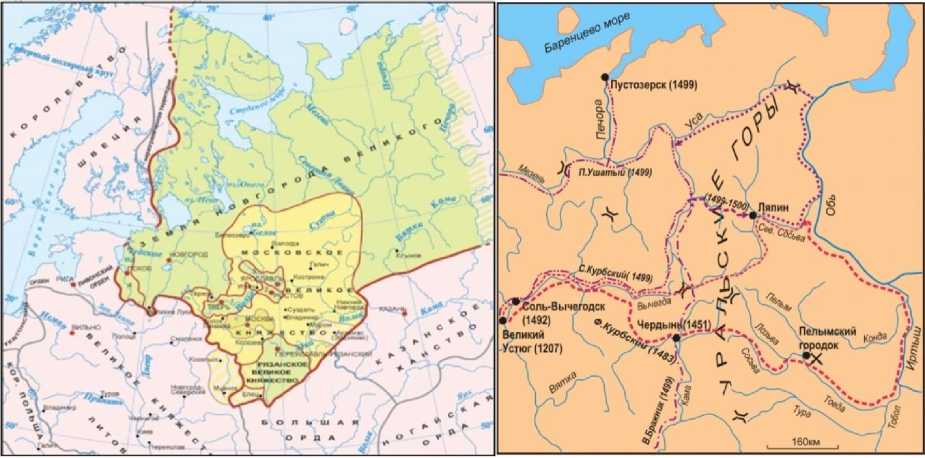
Fig. 5. The lands of Velikiy Novgorod, annexed to the Muscovite state in 1478; campaigns of Russian troops to the Urals and Western Siberia from 1472 to 1500 [2].
The rapid growth and strengthening of the Russian state required large expenditures. Imports of metals, primarily silver, could not satisfy the growing demand and led to dependence on other states. The annexation of these territories dramatically increased the amount of furs harvested for trade. However, Moscow was well aware that it was necessary to find a source of metals on its own territory.
The first mining expedition of the Russian state in the Arctic zone
Purposeful searches for ore deposits, primarily copper, gold and silver, began in the newly annexed north-eastern territories. Now it is difficult to say from what sources Ivan III had known about the deposits of these metals, but the entire subsequent course of events indicates that he had such information.
Herodotus noted that “... in the northern part of Europe there is undoubtedly a lot of gold, but I cannot say anything reliable about the method of its extraction”. Obviously, there was some specific evidence of copper and silver ores in these places, since the Novgorodians were actively trading with local tribes. For a long time, the Chud tribes were mining ores and smelting metals in the northern regions, and information about this, probably, reached the Novgorodians.
“Until now, we used precious metals got by trade through Yugra (the current Pechora Territory). But there has long been a rumor that the countries near the Kamennyy Belt (Urals) are rich in metals”, wrote N.M. Karamzin [6]. Italians, who actively penetrated Rus’ through the southern Genoese colonies, also showed interest in the northern territories and repeatedly visited them. There is a known letter of Grand Duke Dmitriy Ioannovich, granting a certain Andrey Fryazev (obviously Italian) with the gift of Pechora: “Duke Dmitriy Ivanovich granted Ondrej Fryazin Pechora, as was his uncle Mathew Fryazin; to hold carts in Perm, as it was until now: and you, Pecheryans, listen to him and honor him, and he will look after you, and come for the fee, as was with my grandfather under the Prince Great Ivan, and under my uncle at Prince Great Semen, and under my father at Prince Great Ivan, so it was under me” [1].
Aristotle Fioravanti, before starting the construction of the grandiose Uspenskiy Cathedral Church in Moscow, went on a journey across Rus' and visited not only Vladimir, which was reflected in the chronicles, but also the northern possessions of the Russian prince, where he could hear about mining of copper and silver ores in these places. Furthermore, in 1481, a description of the newly annexed northern Novgorod lands was made. This description was carried out in most of the Komi region and became a legislative act that finally secured the entry of this territory into the Russian state.
Wishing to organize the prospecting and exploration of ore deposits, Ivan III was actively looking for mining specialists, sending ambassadors to different countries with instructions to find such people. The text of Ivan III’s official parting words to the ambassador of the Hungarian king Matthias I Corvinus, upon his departure from Moscow in 1488, says: “The Great Prince ordered you to say to our brother Matthias, to make friendship, send us masters ... who he knows gold and silver ore, who can separate the ore from the soil; there is gold and silver ore in my land, but nobody knows how to separate it from the soil...”.
In 1490, “the Monarch sent a Greek, Yuri Trakhaniot, or Trachonite, to German land who went to us with the Grand Duchess Sophia, instructing him as follows: “... Search in Germany and accept into Russian service useful artists, mining craftsmen, architects and others”. Trakhaniot went (March 22) from Moscow to Revel, to Lübeck and Frankfurt, where he was introduced to the Roman King Maximilian I. Such specialists were apparently found. “We saw that he wrote about that to the King of Hungary; but Trakhaniot seems to be the first to take them out of Germany” [6].
On March 26, 1491, Ivan III sent the first state mining expedition from Moscow in search of silver and copper in the Pechora River basin. The expedition included two “Germans”, Ivan and Victor. The expedition was led by “boyar children” Andrey Petrov and Vasiliy Ivanov Boltin. The miners reached the Northern Dvina, then went along the Vychegda, Vym and its tributary Tetera to the Ukhta, and further along the Ukhta, Izhma and Pechora to Tsilma, arriving there by the summer. Searches on the spurs of the Timan Ridge were successful — on August 8, 1491, silver and copper ore were found on the Tsilma (“not reaching the Kosma River for half a day, and from the Pechora River for seven days”).
Seven months later, on October 20, 1491, they returned to Moscow with the news that on August 8, they found not only silver, but also copper ore on the Tsilma River, 20 miles from the Kosma River, 165 miles from the Pechora River (seven days way from Pechora), 3500 miles (3374 km) from Moscow. The copper fields were found at a considerable distance: “... and the places where they found it were ten versts away”. The success of the expedition was due to the fact that its participants, apparently, had some information about ore deposits. Possibly, the mining masters were guided by the traces of some old workings (Fig. 6).
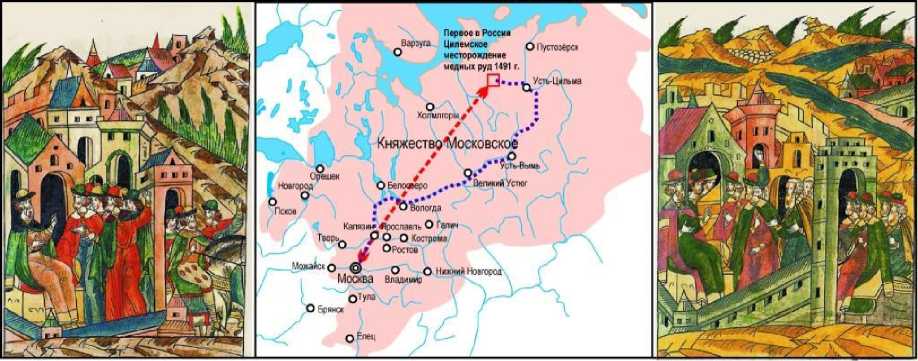
Fig. 6. Departure of the expedition to the Pechora (а) 3, Fig. 6. Departure of the expedition to the Pechora (c) 4.
The year 1491 is considered to be the beginning of the mining industry in the Russian state [6]. The Tsilemskoe deposit was the first developed ore deposit in the history of the Russian state. However, the extreme remoteness from habitable places, the lack of transport routes and the poverty of ores made the mining of silver and copper at the Tsilemskoe deposit unprofitable, and in a few years, it was stopped.
-
3 Litsevoy letopisnyy svod. Kniga 17 [Front Chronicle. Book 17]. Moscow, Akteon Publ., 506 p. URL: http://www.akteon-elib.ru/New_Edition/LITsIeVOI-LIeTOPISNYI-SVOD.-Russkaia-lietopisnaia-istoriia.-Knigha-17./ (ac-
cessed 19 July 2022).
Ibid.
Copper ores at Tsilma are found in Upper Devonian sediments. They are represented by several types (Fig. 7). The first type is small carbonized plant fragments with copper greens, found in red-brown silty sandstones. The second type is bluish-gray siltstones impregnated with chalcocite and oxidized copper minerals, forming lenses, thin interlayers traceable over several meters, and irregular spotty discharges. The thickness of the lenses does not exceed 50–70 cm; the thickness of the interlayers is 20–30 cm. The copper content is up to 11%. These lenses and interlayers contain rich copper ores, represented by phytomorphoses of chalcosine on plant remains. The copper content is up to 33% [12].

Fig. 7. Tsilemskoe ores: a - first type, b - second type (photos by E.V. Kolonichenko, IG Komi SC UB RAS), c - samples of Tsilemskiy rich copper ores from the collection of the museum of St. Petersburg Mining University, 1911 (photos are provided by Shabalov M.Yu.).
In 1492, as N.M. Karamzin reports in his “History of the Russian State”, Ivan III sent “Manuil Ilairev and the boyar children Vasiliy Boltin and Ondryushka Petrov with masters from Italy to make silver and copper on the river on Tsilma, and 60 workers to dig ore from Ustyug, from the Dvina — 100 people, from Pinega — 80 people, and Permich and Vymych and Vychegzhan and Usolich — 100 people” [6]. This second expedition, which already numbered about 350 workers, founded copper mines on the Tsilma, 7 km upstream of the confluence of the Rudyanka River, and set up smelting furnaces. This place is still called “At the factories”. The remains of ore developments at Tsilma were also found 10 km from the mouth of the Kosma River.
Five years later, a copper smelting plant, powerful for those times, was built there, which smelted not only copper, but also silver and even gold, contained in the ores “in small quantities”. Specialists from Italy participated in the work (Fig. 8).
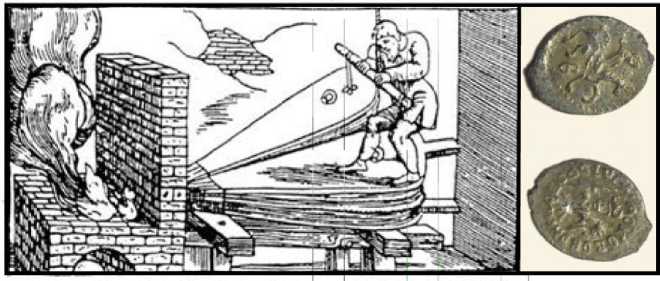
Fig. 8. Smelting furnace in the Middle Ages, silver coins of Ivan III [3].
The smelted metal was sent by rivers to Vologda, and from there to Moscow. The silver ores proved to be too poor to be exploited. Soon, copper mining also ceased — it was too difficult to supply miners and export the mined ore, and the mining season was very short (Fig. 9).

Fig. 9. Traces of mine workings of the Tsilma deposit today. Tsilma River bank with copper sandstones; ancient mine workings; vertical mine workings (photos by E.V. Kolonichenko, IG Komi SC UB RAS).
The Tsilemskoe deposit was the first developed ore deposit in the history of the Russian state. It strengthened the position of Moscow, and the great Moscow princes cherished it, since the Urals and its ore deposits did not yet belong to the Moscow principality.
Because of the exploitation of the Tsilemskoe ore deposits in the lower reaches of the Pechora, in 1499, on the order of Ivan III, the first Russian city beyond the Arctic Circle, Pustozersk, was founded, which played a prominent role in organizing the prospecting and development of ore deposits in the Pechora region (Fig. 10). Pustozersk served as the starting point for mining expeditions to Pechora, Novaya Zemlya and other Arctic islands.
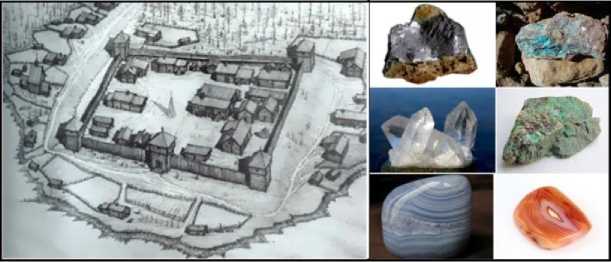
Fig. 10. Pustozersk, 1499 (reconstruction); samples from Pustozersk treasury.
There was a special hut for miners in Pustozersk. The Pustozersk treasury maintained “silver ores weighing a zolotnik, and two pieces of copper ores, and a crystal pebble; and two cornelian pebbles”, sent “as a sample” from the order of the Great Treasury [11].
Development of mining and metallurgy in the northern regions of Russia in the 16th and 17th centuries
In the 16th and 17th centuries, the search for ore deposits continued. In the middle of the 16th century, Tsar Ivan the Terrible sent miners to search for silver ore on Novaya Zemlya, following the example of the Novgorodians, who discovered the islands at the beginning of the 11th century. There were legends that silver came to the surface in the vicinity of Serebryanka Bay, north of the Matochkin Shar Strait, “like incrustation” [11]. At the same time, the monks of the
Pechenga Monastery on the Kola Peninsula were mining polymetallic silver-bearing cores on the coast of the Cold Sea, and also went to the Pechenga River to wash gold [15].
In the 16th century, a new attempt was made to exploit the Tsilma ores. In 1547, Ivan the Terrible invited two mine experts from Saxony to Russia. Perhaps, after their arrival, he sent Ivan Fedorovich Shishkin to the Northern Dvina and ordered him “to take people here, go to Tsilma to dig ore”. Shishkin “dug ore”, but it “was not good” (Fig. 11).
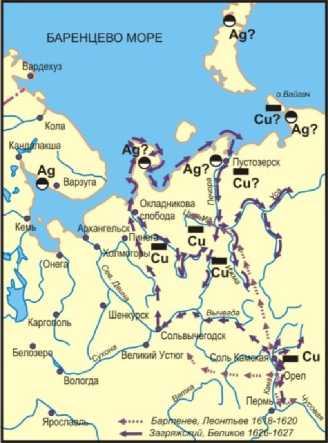
Fig. 11. Routes of mining expeditions in 1618–1620 and 1625–1627 [7].
In 1618–1620, the expedition of Ch. Bartenev and G. Leontiev searched for silver and copper ore in the Kama and Pechora regions. The expedition was sent to the Kama region after the reports of 1617 by Yakov Litvinov, who was in the service of the Stroganovs, that there were outcrops of copper ore in many places of Great Perm. The expedition also worked in the Pechora region, but found only abandoned mining areas of the Tsilemskoe deposit and took samples of ores. In 1626–1627, G. Zagryazhskiy and S. Belikov also searched for silver ores in the basins of the Mezen, Pinega, Kevrola, Pechora and its tributaries on the Kanin Peninsula. But there were no positive results.
In 1633, an expedition headed by V.I. Streshnev and V. Sergeev was sent to Perm Velikaya to search for gold ores. The expedition failed to find gold, but industrial deposits of copper ores were discovered in the Solikamsk and Cherdyn uyezds. In 1636, the Pyskorskiy (Grigorovskiy) copper-smelting plant was built here (Fig. 12) [10].
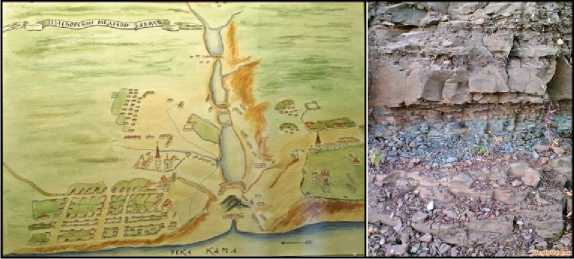
Fig. 12. Pyskorskiy copper-smelting plant (from the album of V. de Gennin, 1735); copper sandstones.
In 1651 and 1652, Tsar Alexey Romanov sent ore-searching expeditions to Novaya Zemlya “to search for silver and copper ores, precious stones and pearls”, as well as “all sorts of useful places”, led by the former Pustozersk governor Neplyuev, which ended tragically [11].
In the late 1640s - 1650s, Moscow began to receive information about searches of silver ores by miners in north-eastern regions of European Russia. In 1653, the Pustozersk ore prospector Ya. Sharapov spoke about the silver ore found on the coast of the Yugorskiy Shar Strait. Silver ore was discovered at Cape Kanin Nos by the Mezen ore prospector A. Mashukov. This information prompted a search expedition from Moscow in 1661 by the explorer V. Shpilkin, which included reconnaissance work on the Kevrol, Mezen, Tsilma and Pechora rivers, on Cape Kanin Nos and on the island of Novaya Zemlya. During three years (1661–1663), the expedition members discovered silver ore on the rivers Volosov, Kambelnitsa and others in the mouth and lower reaches of the Pechora [4].
In 1667, the expedition headed by the Pustozersk governor I. Neelov and the Mezen ore prospectors F. Kyrkalov and G. Ikonnik made another attempt to develop copper ores on the Tsil-ma River for “exploration and experiment”. In 1668, the area of the Tsilma River and the coast of the Barents and Kara Seas were surveyed and samples of discovered copper ores from the rivers Tsilma, Krasnaya, Izhma and Vybor from Pustoozero and Vaygach Island were delivered to Moscow [11].
Later, the Moscow authorities became aware of discoveries of silver on Medvezhiy Island in the White Sea, from which the masters of the Kirillo-Belozerskiy Monastery produced various silver items. To verify this information, several expeditions were sent to the island (Major A. Mamkeev in 1671, clerk of the Novgorod prikaz A. Zinoviev in 1673, attorney L. Narykov in 1676 and Belozersk nobleman P. Malozheninov in 1680). But none of them could discover ore deposits, hidden by the local population. The deposit was found only in 1732 [9].
In 1675, an expedition was sent to Tsilma under the leadership of Yeremey Tradel and ore explorer Lavrentiy Nitart, which found that “although there was copper ore in these places, it was impossible to find it with little money” [7].
Conclusion
Ivan III, Prince of Moscow sovereign of all Rus', whose reign resulted in the union of a large part of the Russian lands around Moscow, which led to its transformation into the center of the Russian state, received the nickname “collector of Russian land”. The unification of these lands under Moscow led to the creation of the largest state in Europe. He laid the economic, political, legal and administrative foundations of the unified state and became the first Russian emperor. The Russian Empire was created.
Ivan III acted as a reformer of the Russian state. He established trade relations with European countries and invited specialists from these countries to work, who brought new production technologies. A large-scale stone construction of new temples and fortresses was launched, in-
REVIEWS AND REPORTS
Konstantin V. Lobanov, Aleksandr Ya. Dokuchaev, Filipp V. Kulakov, Mikhail V. Chicherov… cluding the assistance of Italian masters, as well as the production of artillery pieces. During his reign, the search for minerals, necessary for the development of the state, began.
One of the key roles in reforming the domestic and foreign policy of the Russian state was played by the second wife of Ivan III, Sophia Palaeologue. She consistently implemented the idea of complete liberation from the Horde dependence, transforming Russia into a powerful state. The country received a new emblem in the form of a double-headed eagle, the idea of inheriting the Byzantine Empire, formulated as “Moscow — the Third Rome”, was established.
1491 was the year of the first state ore-searching expedition, which was carried out in the Arctic zone of Russia, and the year of the beginning of the mining and metallurgical industry in the Russian state. The main reason for that was the attention to this issue of Grand Duke Ivan III, who carried out a great preparatory work to collect the necessary information, search for relevant specialists and find the required financial resources.
Silver and copper ore was found on the Tsilma River, a tributary of the Pechora River. Copper was found at a considerable distance. The rapid success of this expedition clearly demonstrates that it had specific information about ore deposits. The year 1491 is considered to be the beginning of the mining and metallurgical industry in the Russian state, and the Tsilemskoe deposit became the first developed ore deposit in the history of the Russian state.
In the 16th-17th centuries, the state continued its efforts to search for new deposits of metallic minerals, including in the newly annexed territories of the Urals and Siberia. State money was used to organize new expeditions, including those involving domestic geologists-miners. The foundations of geological prospecting, exploration and mining were laid. Methods and forms of state participation in the development of domestic mining industry were developed and improved. The development of mining and metallurgical industry in Russia was started for many years to come.
Список литературы History of the First Ore Prospecting Expedition of 1491 in the Arctic Zone of the Russian State
- Akty, sobrannye v bibliotekakh i arkhivakh Rossiyskoy imperii arkheograficheskoyu ekspeditsiey Im-peratorskoy akademii nauk [Acts Collected in the Libraries and Archives of the Russian Empire by the Archeographic Expedition of the Imperial Academy of Sciences]. Saint Petersburg, 1836, vol. 1, 548 p. (In Russ.)
- Arkhipova N.P., Yastrebov E.V. Kak byli otkryty Ural'skie gory [How the Ural Mountains Were Dis-covered]. Sverdlovsk, Middle-Urals Book Publishing House, 1990, 224 p. (In Russ.)
- Borzova E.P. Istoriya mirovoy kul'tury [History of World Culture]. Saint Petersburg, Lan Publishing House, 2001, 672 p. (In Russ.)
- Glembotskaya T.V. Gornorudnyy promysel v rossiyskom gosudarstve [Mining in the Russian State]. Gornyy informatsionno-analiticheskiy byulleten' (nauchno-tekhnicheskiy zhurnal) [Mining Informa-tional and Analytical Bulletin (Scientific and Technical Journal)], 2009, no. 12, vol. 14, pp. 238–248.
- Ievlev A.A. Istoriya izucheniya serebryanykh rudnikov Ivana III [Investigations of Silver Mines in the Era of Ivan III]. Voprosy istorii estestvoznaniya i tekhniki [Studies in the History of Science and Tech-nology], 2014, no. 1, pp. 50–68.
- Karamzin N.M. Istoriya Gosudarstva Rossiyskogo: V XII tomakh. V 3 knigakh. Kniga 2. T. V–VIII [His-tory of the Russian State: In XII Volumes. In 3 books. Book 2. Vol. V–VIII]. Moscow, AST Publishing House, 2008, 733 p. (In Russ.)
- Kurlaev E.A., Mankova I.L. Osvoenie rudnykh mestorozhdeniy Urala i Sibiri v XVII veke [Development of Ore Deposits in the Urals and Siberia in the 17th Century]. Moscow, Drevlekhranishche Publish-ing House, 2005, 324 p. (In Russ.)
- Maksakovskiy V.P. Obshchaya ekonomicheskaya i sotsial'naya geografiya. Kurs lektsiy. Chast' 1: uchebnik dlya vuzov [General Economic and Social Geography. Lecture Course. Part 1: Textbook for Universities]. Moscow, VLADOS Publ., 2008, 500 p. (In Russ.)
- Maksimov M.M. Ocherk o serebre [Essay on Silver]. Moscow, Nedra Publ., 1981, 207 p. (In Russ.)
- Medeplavil'nye zavody Permskogo kraya (XVII–XIX vv.) [Copper-smelting Plants of the Perm Territo-ry (17th-19th Centuries)]. Perm, 2011, 43 p. (In Russ.)
- Okladnikov N.A. Rossiyskie kolumby. Mezenskie polyarnye morekhody i zemleprokhodtsy (XVI – nachalo XX veka) [Russian Columbuses. Mezen Polar Sailors and Explorers (16th Early 20th Centu-ry)]. Arkhangelsk, Pravda Severa Publ., 2008, 358 p. (In Russ.)
- Ostashchenko B.A. «Tsarskie rudy» Tsil'my [“Royal ores” of Tsilma]. Vestnik IG Komi NTs UrO RAN [Vestnik of the Institute of Geology of the Komi Science Center of the Ural Branch of the Russian Academy of Sciences], 2000, no. 12, pp. 15–16.
- Panova T.D. Velikaya knyaginya Sof'ya Paleolog [Grand Duchess Sophia Paleolog]. Moscow, Mos-cow Kremlin, 2005, 54 p. (In Russ.)
- Tatishchev V.N. Istoriya Rossiyskaya. Sobranie sochineniy v 8 tomakh. T. 6 [Russian History. Collect-ed Works in 8 Volumes. Vol. 6]. Moscow, Ladomir Publ., 1996, 438 p. (In Russ.)
- Ushakov I.F. Izbrannye proizvedeniya: Istoriko-kraevedcheskie issledovaniya [Selected Works: Histor-ical and Regional Studies]. Murmansk, Murmansk Publ., 1998, vol. 2, 368 p.; vol. 3, 473 p. (In Russ.)
- Khoroshkevich A.L. Torgovlya Velikogo Novgoroda s Pribaltikoy i Zapadnoy Evropoy v XIV–XV vekakh [Trade of Veliky Novgorod with the Baltic States and Western Europe in the 14th-15th Centuries]. Moscow, AS USSR Publ., 1963, 366 p. (In Russ.)

